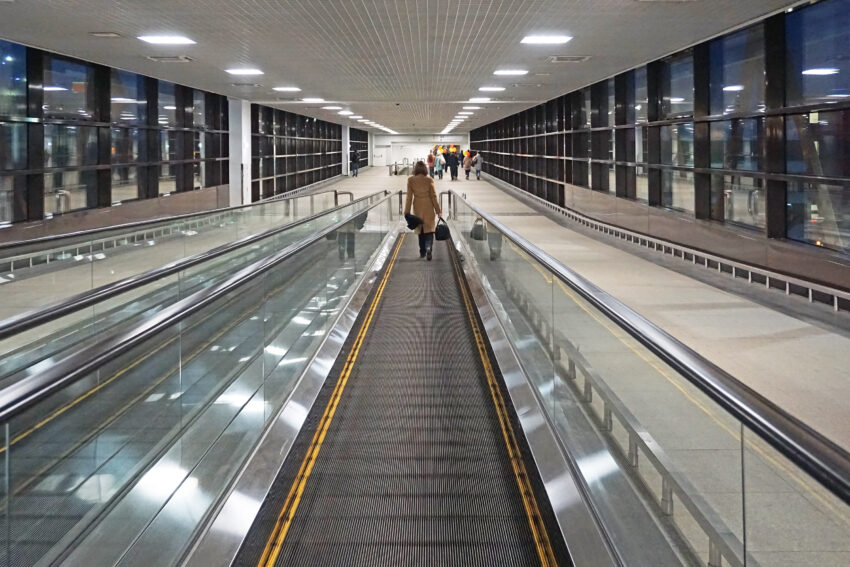You’ve probably been on a travelator when visiting the airport and moving through terminals, or on a train station while moving from one platform to another.
A lift can only move vertically, but a travelator can move both horizontally and vertically (when it’s at a certain incline).
Travelator is an exclusively British-English term, but you might have heard other words such as moving walkways, auto walk, moving pavement, people-mover or travelater to refer to the same phenomena.
What Exactly is a Travelator?
What separates travelators from other automated forms of travel is their inclination. Escalators move vertically and are inclined at an angle of 30 degrees, while travelators move horizontally over a long distance at an incline of 10, 11, or 12 degrees.
Travelators are not a new concept by any means; they were launched in 1893 and have continued to inspire science fiction writers and businesses alike with their streamlined design and ease of use.
What Are the Types of Travelators?
Travelators mainly come in two types:
Pallet Type
These are travelators with metal plates that are often covered with an additional rubber surface for friction; assembled similarly to escalators. They are usually found in commercial buildings with a large staff that needs to move around from one spot to the next in vast packs.
Their speeds are usually 1.6 ft per second to reduce the chances of unfortunate accidents. Walkways are usually either flat or inclined, but they can be flat and inclined in the same belt if the transportation calls for a bit of vertical distance to be covered, too.
Moving Belt Type
Moving belt travelators are built with metal mesh plates or rubber surfaces with metal rollers that create a springy surface. Their work is similar to a conveyor belt.
You will find that they are quite often used in shopping malls, where the surface provides friction to carts to keep them from slipping if the traveler is at a certain incline. These travelators can also have a variety of inclines and either be flat or inclined, or both simultaneously.
How to Determine You Need a Travelator?
Your purpose and environment need to be examined to determine if you need a travelator and which one you need to use.
Should You Get a Pallet-type Travelator?
If there is a substantial public flow in a business building, you should get a pallet-type travelator. Travelators are usually used to service huge crowds in hectic environments, since a normal escalator or elevator can not adequately meet the transportation needs of all those people in a given amount of time.
Should You Get a Moving Belt Travelator?
A moving belt travelator would suit you better if you intend to place them in a mall or certain airport areas where luggage is tugged around in huge carts. The surface of this particular traveler ‘locks’ the shopping and luggage trolleys in and keeps them from rolling haphazardly. It is particularly useful when the travelator is at an incline and keeps the public safe with its lock feature.
How Eco-friendly Are These Travelators?
These travelators are assembled with various features that help curb power costs and reduce power wastage. Their earth-friendly characteristics also help.
Lubricant Free
The step chain doesn’t need to be oiled, which saves oil, decreases chain damage, and diminishes fire risk.
Automatic Shut-off
If the travelator senses that the flow of movement is less, it either slows itself down or shuts itself off using its sensors to save power.
How safe are these walkways?
Several companies offer state-of-the-art safety guidelines and features for public health and help curb as many unfortunate accidents as possible.
Traffic Signals
Colored and placed on the sides of the travelators, you will find traffic signals. These offer visible directions to the public to educate them on how to carry themselves in a walkway to minimize the risk of accidents and danger.
Non-Flammable Wiring
The wiring is composed of non-flammable gasses and is resistant to fire to avoid explosions in the event of any calamity.
Earthquake Sensors
Its built-in sensors detect activity and take the appropriate measures to decrease danger and risks to the health of the people around it.
Do Travelators Require Professional Care?
These impeccable machines are costly and require arduous labor. The interior parts of these contraptions are very delicate and require meticulous engineering, which is why it is best to get them professionally installed and maintained by a trusted contractor. Regular checkups can prevent public health hazards such as machine breakdowns, which can endanger the building.
In conclusion, travelators are some of the most streamlined ways to make long walks more efficient. You can find a good elevator company in Dubai that offers travelator installation, repairs, maintenance, and modernization of old models. So what are you waiting for? Get your travelator installed now!

